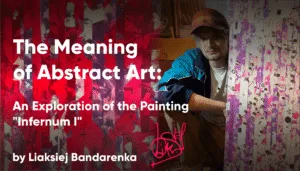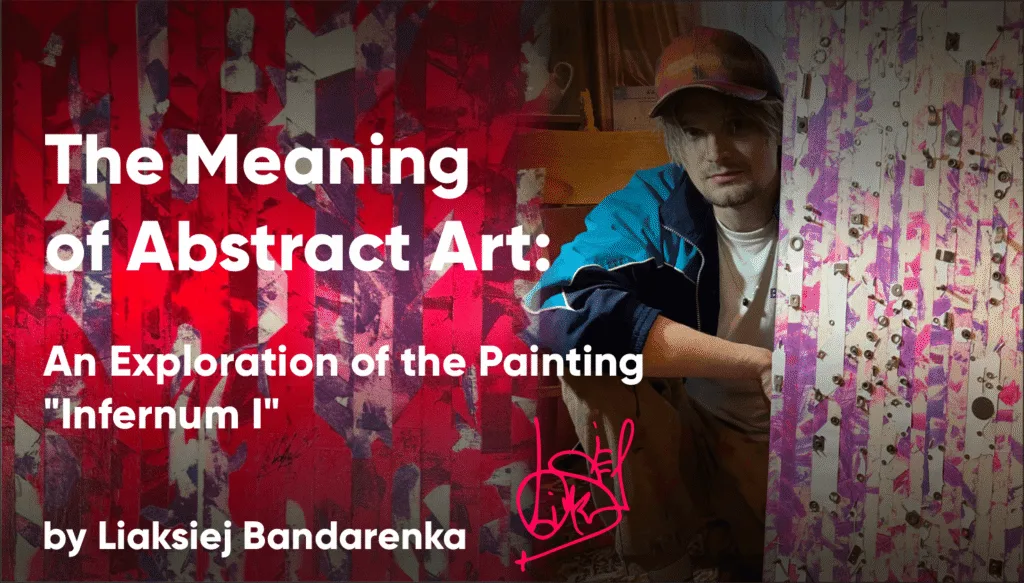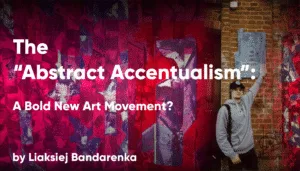The Meaning of Abstract Art:
An Exploration of the Painting “Infernum I” by Liaksiej Bandarenka
Intro
- This presentation will walk you through my first painting from the “Infernum” series. I’ll share how the idea came to life and show the process of creating this abstract piece with step-by-step photos and my thoughts along the way.
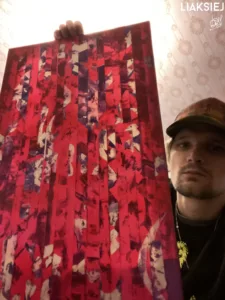
Me and painting “Infernum I”
- I’ll talk about what I managed to achieve while working on this abstract painting, what didn’t quite work out, the mistakes I made, and how I see this painting and the whole series overall.
The Context of the Painting and the Principles of Abstract Accentualism
- The painting “Infernum I” is an abstract painting created using my unique technique, Abstract Accentualism. Further details about this artistic approach are discussed in a dedicated article focused entirely on this style.
- In this article, I want to highlight that Abstract Accentualism is my artistic technique. It’s all about selecting distinct individual objects within a chaotic abstract composition—one that might initially seem mysterious, unclear, and like a mix of random colors.
- The Infernum series presents itself as an abstract reflection on a place none of us should aspire to. Hell represents the ultimate lost soul—where there’s no light, no love, no creativity or beauty. It’s a place without anything that could save the soul, but full of everything that leads to eternal suffering.
- The road to Hell is built by a person’s own actions, and only they can choose to turn things around. Through abstraction and the power of human imagination, my work aims to prompt viewers to engage in introspection and pose questions to themselves. Wondering about the role of love, creativity, compassion, and all the noble, bright things that lift our spirits and elevate our soul. Questions about worries and fears often come up when you have an honest conversation about yourself, your actions, and your intentions.
- My paintings depict terrifying monsters confined in a hellish space, whose appearance may evoke interest solely due to their tragic fate — one that is far from being an aspirational model for the viewer.
- I would like to note that, for the viewer, an abstract composition and the interplay of artistic imagery can be appealing in itself. The personal significance I attribute to the paintings created within the context of this abstract, infernal theme is not immediately apparent and, as a result, is not universally recognized as fundamental. That is entirely normal, and in fact, I appreciate when viewers allow their imagination to take them on a journey different from the one I have envisioned through my work. This is the nature of abstraction, and it is an essential aspect to consider.
- This is an important consideration. In the future, if deemed necessary, I plan to write a more detailed article about my series of paintings, “Infernum.”
The initial phase of creating a painting
Ribbon preparation process
- After completing the painting ‘Queen of Justice’ and several other works that exemplified my artistic approach of Abstract Accentualism, I sought to create a canvas painting using this technique.
- So, I decided to buy a canvas and figured I’d use my painted masking tapes to create a single, complete abstract composition on it. From there, I planned to look for individual abstract shapes within the piece and highlight them against the overall pink-red background.

Getting ready to make painted tapes

The place where I make my art
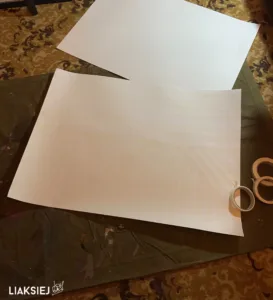
Masking tapes stuck to the paper, ready for some paint
- These painter’s tapes with textured color combinations came about while I was creating random textures on large paper. However, it turns out the textures on painter’s tapes and paper aren’t quite the same, and you’ll see the difference in my painting Infernum IV. For that piece, I used painted paper tapes instead of painted masking tapes.
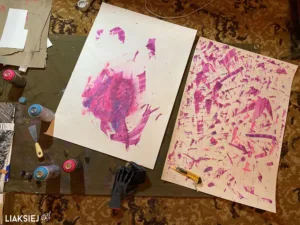
First steps
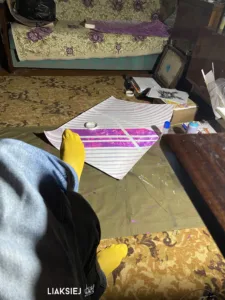
On a break
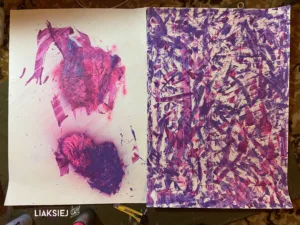
The process of making painted tapes

Painted tapes are ready for work
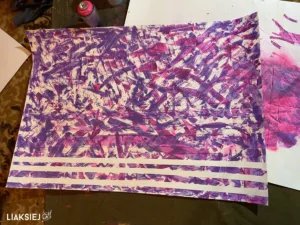
The process of making painted tapes
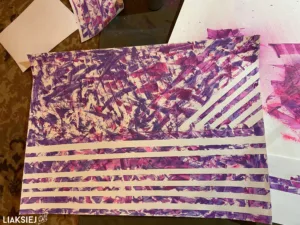
The process of making painted tapes
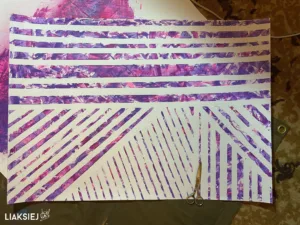
The process of making painted tapes
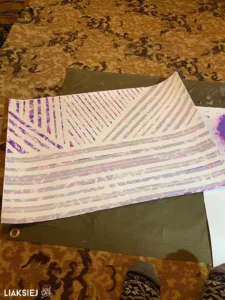
The process of making painted tapes
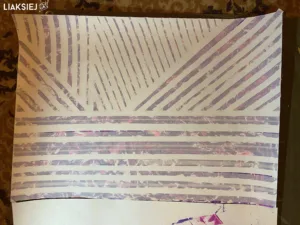
The process of making painted tapes
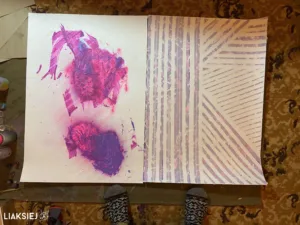
The process of making painted tapes
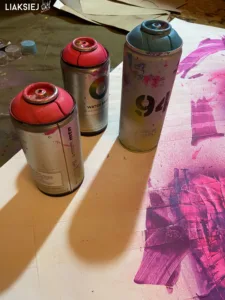
Sparay paints for mixing [Montana Colors: MTN 94 and MTN WB]

The process of making painted tapes
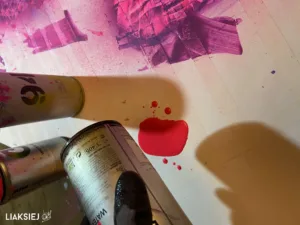
The process of making painted tapes
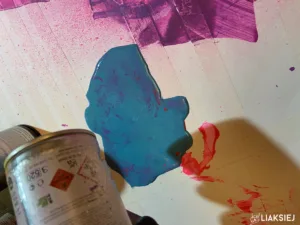
The process of making painted tapes
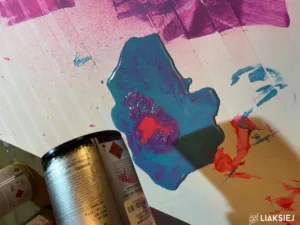
The process of making painted tapes
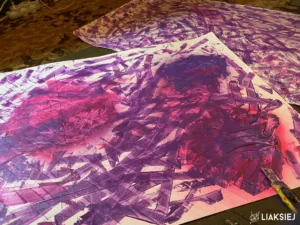
The process of making painted tapes

The process of making painted tapes
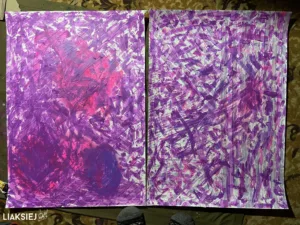
The process of making painted tapes
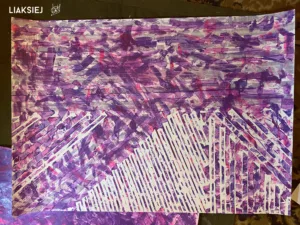
The process of making painted tapes

The process of making painted tapes
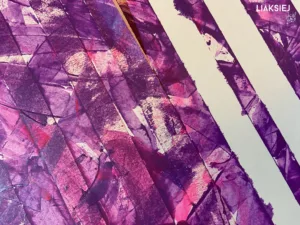
The process of making painted tapes
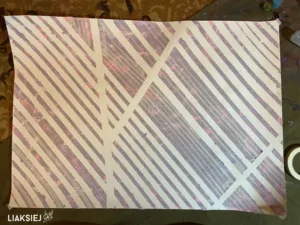
The process of making painted tapes

The process of making painted tapes

The process of making painted tapes
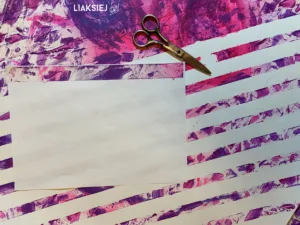
The process of making painted tapes
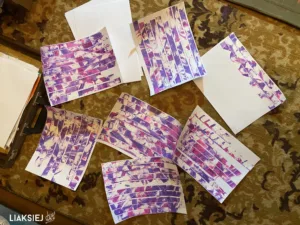
Painted masking tapes for my paintings
- After collecting plenty of painter’s tape with colored textures and storing it in an old Soviet case, I waited for the right moment to prep the canvas.
The next phase in the process of creating an abstract painting
Adhering colored ribbons to canvas
- After getting some PVA glue, I started gluing the ribbons one by one onto a 40x120cm canvas. It was a slow, methodical process that took quite a bit of time. What made it so exciting was the sense of unpredictability. Now I know exactly what my abstract paintings from the “Infernum” series are all about, but back then, it was a creative journey where I had no idea how it would turn out. Strangely enough, that sense of the unknown is what keeps inspiring me to keep going.

The blank canvas is prepared for applying my painted masking tapes

The process of gluing painted masking tapes
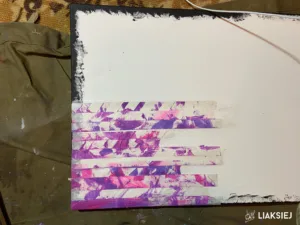
Sticking down painted masking tapes
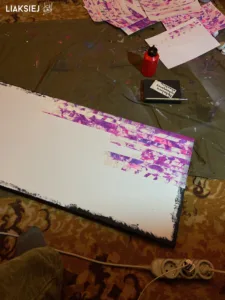
Sticking down painted masking tapes
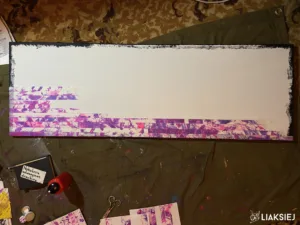
Sticking down painted masking tapes
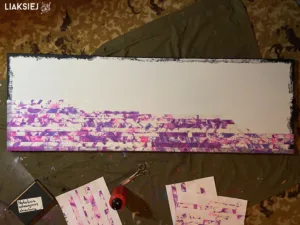
Sticking down painted masking tapes

Sticking down painted masking tapes
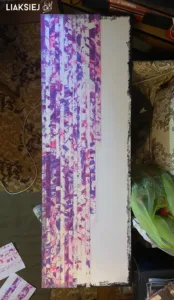
Sticking down painted masking tapes
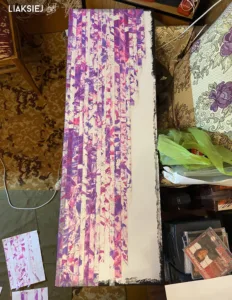
Sticking down painted masking tapes
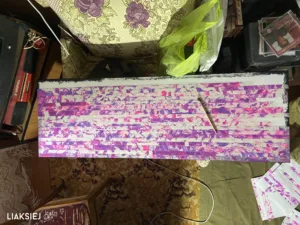
Sticking down painted masking tapes
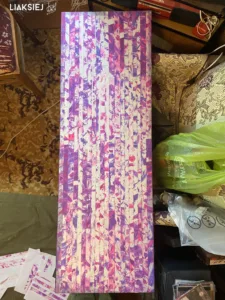
Sticking down painted masking tapes
The third step in making a painting
- The longest stage of creating this abstract painting is finally here. On the canvas, amidst the abstract chaos, I’ve been searching for distinct, separate abstract shapes to bring forward. By highlighting these shapes, I create the main focal points of the painting. That’s why I call my artistic style Abstract Accentualism.
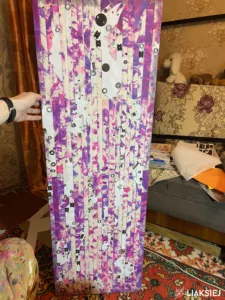
Abstract objects shielded by paper stencils
Identifying specific abstract objects for emphasis
- When I identify an intriguing object on the canvas, I meticulously trace its boundaries onto paper, carefully cut along the edges, and create a protective paper stencil. This stencil is then used to cover the object on the painting, secured precisely in place using magnets and steel components.
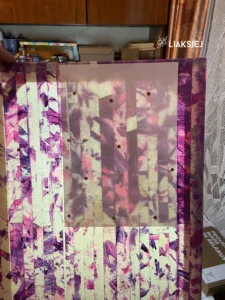
Creating shielded paper stencils
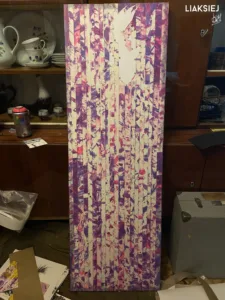
The process of identifying individual abstract objects within the painting
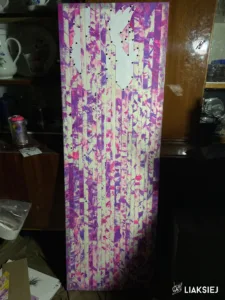
The process of identifying individual abstract objects within the painting
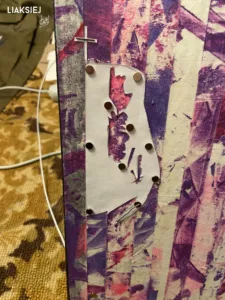
Protected abstract object by shielded paper stencil
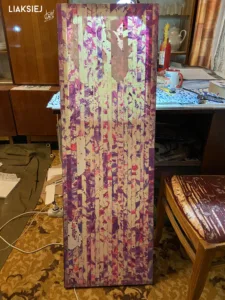
The process of identifying individual abstract objects within the painting
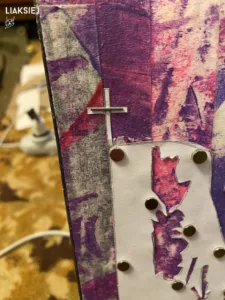
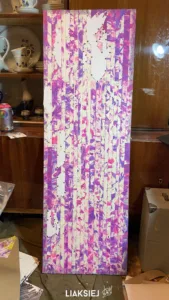
The process of identifying individual abstract objects within the painting
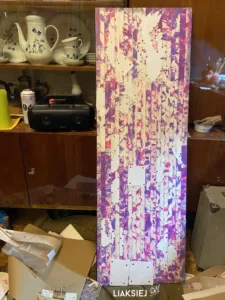
The process of identifying individual abstract objects within the painting
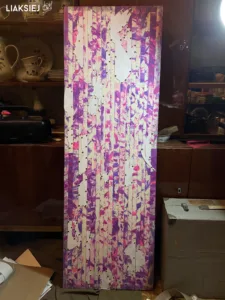
The process of identifying individual abstract objects within the painting
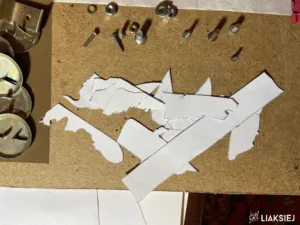
Protective paper stencils designed for safeguarding abstract objects during painting
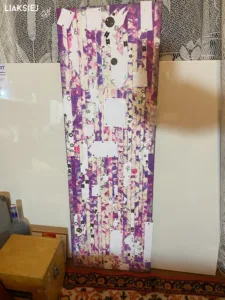
The process of identifying individual abstract objects within the painting
The canvas fell, and the protective paper collapsed
- It happened so fast, but at the same time, I kind of saw it coming. The thing is, I work in a pretty tight space, and at the worst possible moment, I ended up snagging the canvas. It wasn’t a great feeling, but I quickly shifted my focus to fixing it.
- Restoring the composition from its displaced positions required nearly a full day. The protective papers were carefully repositioned, returned to their original places, and secured once again using magnets.

Magnets for holding shielded paper stencils on canvas
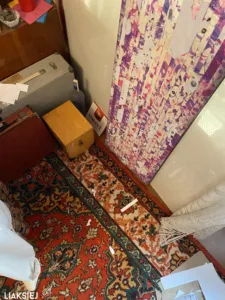
Magnets, steel pieces, and paper stencils left behind as the canvas falls

Following the restoration of stencils on canvas
The fourth step in the process of creating an abstract painting
Spray paint application
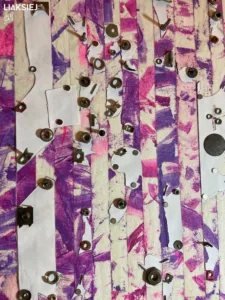
The process of identifying individual abstract objects within the painting

The process of identifying individual abstract objects within the painting
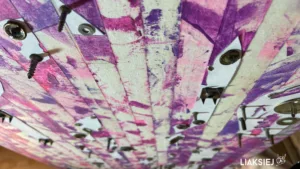
Paper stencils help protect the individual abstract elements in a painting
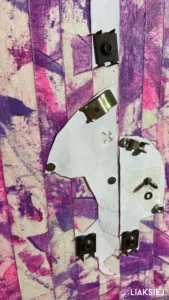
Paper stencils help protect the individual abstract elements in a painting
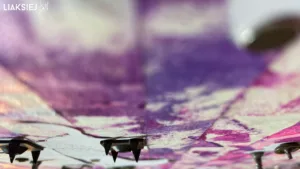
Paper stencils help protect the individual abstract elements in a painting
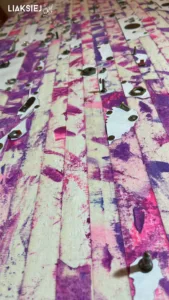
Prepared the canvas prior to applying the primary background layer of fluorescent fuchsia
painting
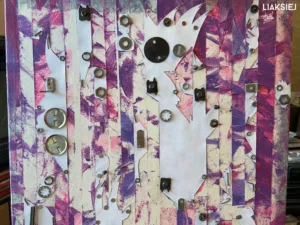
Prepared the canvas prior to applying the primary background layer of fluorescent fuchsia
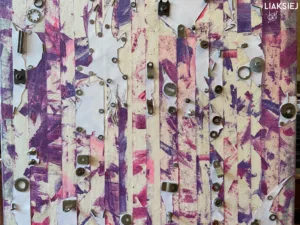
Prepared the canvas prior to applying the primary background layer of fluorescent fuchsia

Prepared the canvas prior to applying the primary background layer of fluorescent fuchsia
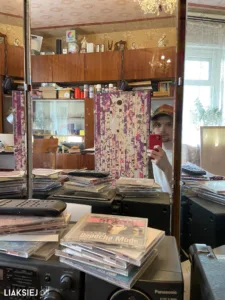
A few selfies taken before applying the primary background color
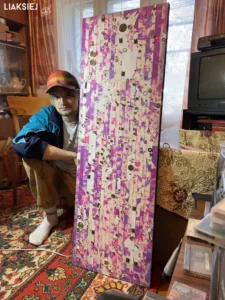
A few selfies taken before applying the primary background color
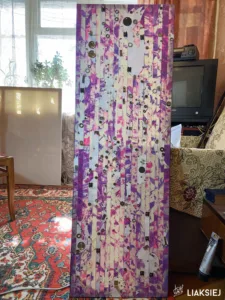
Let’s go!
- Once everything was prepared, I stepped onto the balcony to take advantage of the fresh air and applied MTN WB Fluorescent Fuchsia spray paint to the uncovered portion of the canvas.
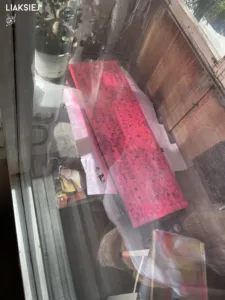
Applying the primary color by spray
- I was pretty excited and it looks like I didn’t wait long enough for the paint to dry completely.

Canvas once dried
- With each layer of protective paper removed, I encountered an experience that had previously been beyond my understanding. My own painting was revealed before me, evoking a similar sensation with every new piece I created using the Abstract Accentualism technique.

Magnets removed from the canvas
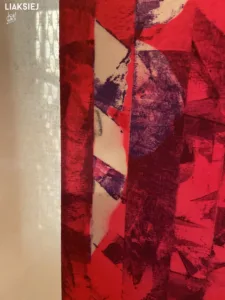
Shielded paper stencils have been removed
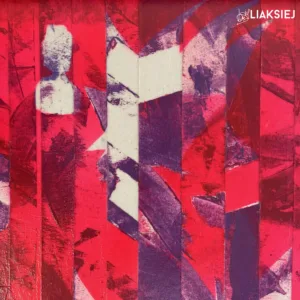
Shielded paper stencils have been removed
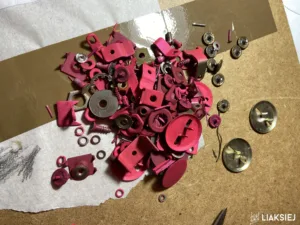
The metal components used to secure the paper with magnets have been removed

The papers used to secure the abstract objects on the canvas have been carefully removed
- When I first viewed the final version of the painting, I didn’t assign it a rating. Over time, my perception shifted—I initially liked it, then began to dislike it. Today, I recognize this painting as one with its share of mistakes and flaws. However, as a pioneering piece in the “Infernum” series and an early example of Abstract Accentualism on canvas, it holds significant value.
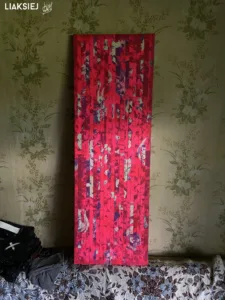
The final view of the painitng Infernum I
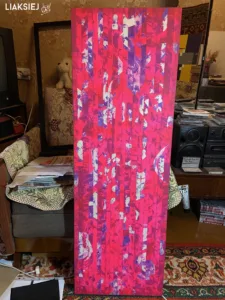
The final view of the painitng Infernum I
The fifth step in the process of creating an abstract painting
Applying varnish to the canvas
- I applied a single layer of acrylic matte varnish from an aerosol can to protect the painting and was pleased with the result. However, I have since transitioned to using matte parquet varnish, as I find it to be the most effective option for both protecting the artwork and enhancing its colors.
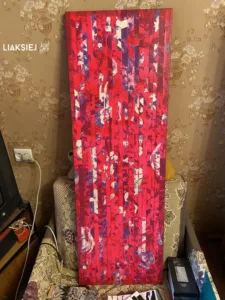
The painting after varnishing
The sixth step in the process of creating an abstract painting
Placing a painting within a wooden frame
- I was concerned that my painting was not yet framed and wanted to ensure the frame was made of wood. Fortunately, I know a skilled craftsman who creates custom frames for me, including one specifically made for the painting Infernum I.
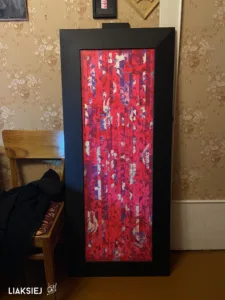
The canvas is finally framed in wood!
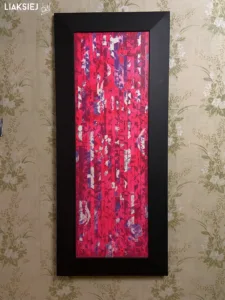
The painitng hanging on the wall
Fluorescent Factor
The MTN WB Fluorescent Fuchsia spray paint I use as the primary layer in my abstract paintings creates a striking effect under UV light in the dark. This gives my paintings an extra touch.

Under UV lights, the painting glows with bright fluorescent colors in the dark

Under UV lights, the painting glows with bright fluorescent colors in the dark
Issues with the painting Infernum I
Ambiguous independent abstract objects in this painting reflect the influence of an initial attempt and limited experience
- In comparison to the painting “Infernum II,” the independent highlighted objects in this work feature more blurred silhouettes and intricate finishing touches. I attribute this to a lack of experience at the time; while working on Infernum I, I found it challenging to distinguish the boundary between a compelling abstract object and a less engaging one. Now, as I work on Infernum IV, I recognize that my standards for what constitutes a beautiful abstract object have evolved significantly, differing greatly from the approach I used when identifying and selecting objects for Infernum I.
- [As I mentioned in my article on Abstract Accentualism, “it is precisely on the clarity of the artist’s imagination that the resulting beauty of the painting depends.”] Similarly, the outcomes of Infernum I reflect the level of my imagination at that particular moment.
Black borders on the canvas
- Before gluing the ribbons to the canvas, I decided to paint the sides with black acrylic for some reason. It ended up making things trickier when working on the edges and darkened the background in those areas.
Accidentally damaged the canvas stretcher myself
- It was an oversight on my part. Before I began gluing the painted strips onto the canvas, I decided to tighten it further. To do this, I inserted additional wooden blocks into the corners of the stretcher, which unfortunately caused a slight warp in the frame.
- Fortunately, this issue was resolved once the canvas was placed in a wooden frame, which straightened it out.
- Interestingly, this mistake ended up becoming a unique characteristic of the painting.
- I avoid re-stretching the canvas, as it involves specific considerations. Since it is not just a standard canvas but one with strips glued to it, altering the tension could potentially damage the glued elements.
A wooden painting frame with an inappropriate shape
- In my view, the shape of the wooden frame should be reversed to create the effect of a tunnel rather than simply revealing the painting.
- Still, despite all the mistakes and flaws, I love this painting. It captures everything I got wrong at the very start of my “Infernum” series. To me, it symbolizes my human imperfections and the value of embracing them, along with the courage it took to take that first step.
- This painting will look worse and worse with each release of my new abstract painting from the “Infernum” series. And that’s where the value and significance of this painting really come through.
- That’s it for now. Thanks so much for your time and attention!
Liaksiej Bandarenka
